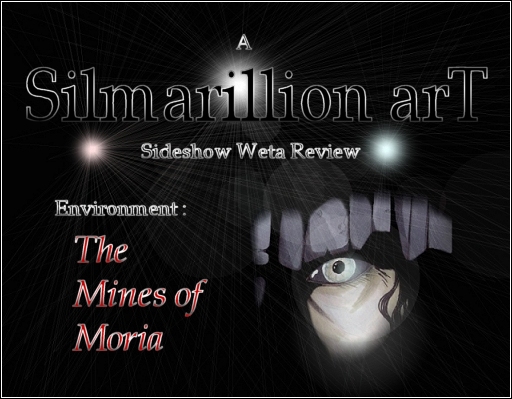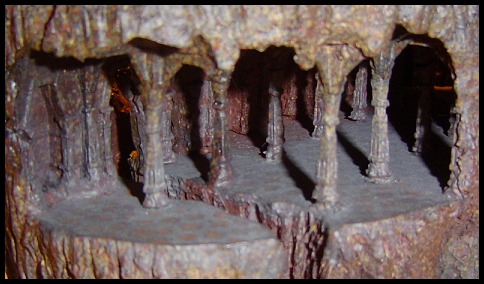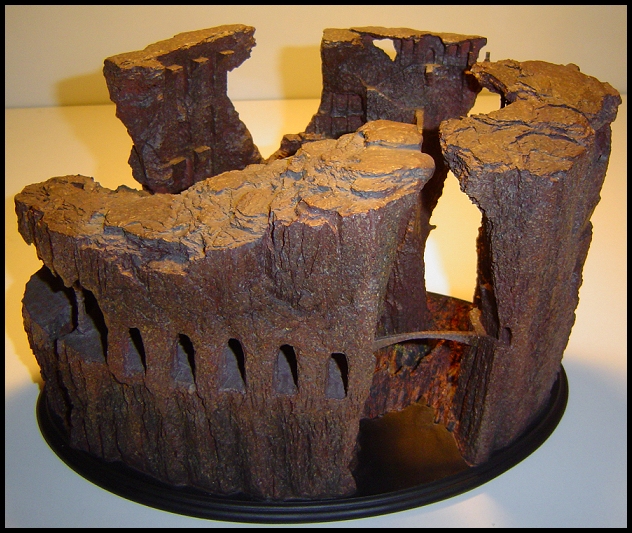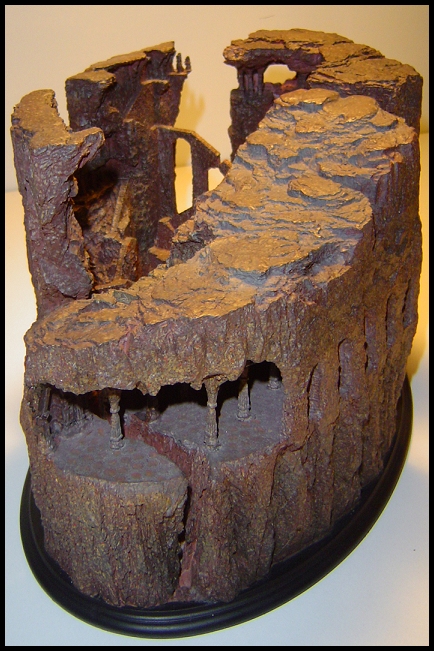


"Few places in Middle-Earth conjured comparable images of darkness and fear at their mere mention than Moria. Once a Dwarf city of light, riches and commerce, the great realm beneath the mountains fell into the possession of evil when the miners disturbed an imprisioned Balrog in the deepest of their delvings. By the time the Fellowship came to the mines the once great halls and corridors were desolate and dark, inhabited only by Orcs and other fell creatures that thrived in the wake of the demon. Despite their misgivings, in they nonetheless would go."



Typical of Sideshowís trend in the line thus far, the packaging is not much to look at. It consists mainly of images of the prototype weíve already seen for months now, with the proper green colorings to mark its rightful place in the Fellowship series lineup. The design of the box itself is very utilitarian. No windows to see the product (some argue Sideshow Wetaís largest drawback in their packaging department) and a very simple rectangular shape. For this particular piece however, it proves to be not just the best, but the only decision they could have made. Once the boxís tab lock is opened and its Styrofoam insides are pulled out, cut the ceremonial tape and the real fun begins.
To my utter shock, Moriaís interior packaging was unlike anything Iíd ever seen before in this line. Inside the nooks and crannies of the polystone were deliberately shaped pieces of Styrofoam, designed to help protect it during shipping. This Iíve seen before, but the whole Environment itself was wrapped in what can only be described as saran wrap, to hold said pieces in place. I was terrified, terrified I tell you, that while pulling everything apart I would somehow damage the tiny details within the sculpture. Thankfully I was wrong, but after the whole ordeal, I felt like I needed a stiff drink.
After two shots of Rum I went back to my display room, and began to examine the piece further.



The first thing youíll notice about Moria is that it is absolutely HUGE. Take the Golden Hall Environment, and then place Helms Deep on top of it, and youíll have a pretty good indication of its sheer size. Itís also quite heavy, about a metric ton by my estimates.
Much can be said about how this particular piece looks. Personal opinions of it from fellow fans range from proclaiming Moria as brilliant, to denouncing it as a lifeless Lump of Clay. One thing that can be said about it however, no matter what you think personally about the final product, is that poor Mary Maclachlan (the sculptor) spent much of her life hunched over a table with tiny, tiny sculpting tools. Moria, if not particularly pleasing to the eye, is the single most detailed sculpture created in the entire Lord of the Rings line thus far, with no exceptions.

A very unique approach was taken in the designing of this piece as well. Instead of arguably taking the easy way out, by creating a particular part of Moria, say, Balinís Tomb, the Crossroads or the Moria Cemetery (coincidently SSW did produce a separate Moria Cemetery Environment, which has yet to make it to mass production), they opted to sculpt a whole chunk of the mountain, including many locales of the memorable scene. This worked VERY well, creating a sculpture unlike any the line has yet seen. Though true that the locationsí proximity to each other have little to no accuracy to their movie counterparts, it creates an almost never-ending feast for the observant mind.
The first structure which is glaringly obvious is the Bridge of Khazad-Dum. The bridge is not very spectacular, being what it is: A thin bridge leading to a small staircase. The interesting effect they have going with it is that itís the only place where the floor is black, attempting to give the effect of the straight drop beneath it. It actually works quite well considering the drop is no more than three inches. The bridge itself is not very detailed, in fact, itís a bare sculpt. The appearance of detail is added with the paint in a very effective way, but the bridge does have a pretty interesting curve to it. Overall Iím genuinely surprised that these are surviving the shipping, because this is one thin piece of polystone.

The next memorable structure you might notice is the Great Staircase from the movie, complete with crack in it. I donít recall reading if this particular set of stairs had a proper name in the text, but Iím pretty sure it didnít (and in fact, in the book, the Fellowship had zero problems crossing it). Anyway, the Staircase takes up the majority of the center opening of the sculpture. All the proper twists and turns are there, making it extremely accurate to its cinematic counterpart. The detail work like the bridge is what youíd expect, but thereís just so much of it, it can become overwhelming at times. One truly excellent portion of the area that I was not expecting at all is the molten rock below the bridge. Itís excellently sculpted, though not painted to the best of its potential (something Iíll address in the paint section). On the interior walls surrounding the Staircase are several doorways and balcony structures, which could clearly be used by the Moria Orcs to shoot at the Fellowship. Subtle touches, all very well done.

The final major structure is of course, Dwarrowdelf. Now, obviously itís not the entire hall, but itís a very nice chunk of it, with two rows of independently sculpted pillars. The floors of the hall are sculpted in tiny tile patterns which match the design from both the movie and the original Balrog statueís base perfectly. The only downside is they are woefully out of scale, and normally at this scale you could not be able to see them at all. Itís honestly not that noticeable though, and Iím glad they made this decision. The area is completely enclosed with a ceiling and a floor. Itís very dark inside the hall (I suggest a flashlight for examination), but five ďwindowsĒ have been carved into the side of the sculpture to allow light. There is also a sizable hole carved away at the rear of the hall to allow viewing. On the opposite side, the hall opens up into the bridge. This is my personal favorite part of the Sculpt, and is no doubt the most impressive from an engineering standpoint (the whole piece is constructed like a jigsaw I imagine, the Seems can be seen in several places). The inside walls also have several pillars sculpted into them to give the effect of endless rows of columns, but it doesnít work particularly well.
Suspiciously absent from the piece is Balinís Tomb. There is one area of the Sculpt, behind Dwarrowdelf in the corner of the piece that ďcouldĒ be it, but thereís no smoking coffin, so to speak. Other highlights include numerous staircases, doorways, pillared chambers and canyons revealing even more doorways, staircases and pillared chambers. Like I said, itís almost never-ending. The only downside to the Sculpt is that the outside is pretty bland. Itís clearly designed to just look like natural rock, which it does, but all the real goodies are contained within.



Ah yes, the one area I worried about since I first layed eyes on this piece way back in 2001 was its paintjob. Letís be honest, when someone thinks of Moria, they think gray. So what does Sideshow do? They paint the entire piece in shades of red, brown and orange. Now, I understand the thought process behind this: the Balrog and Staircase scenes which took place primarily over lava pits were these colors, and they were among the most memorable scenes in Moria. However, this color scheme is not appropriate for the whole sculpture. What they should have done, and what would have made the piece far more appealing to people in my opinion, is this: They should have painted the ďouter shellĒ of the piece in grays and blues, and kept the insides (the Staircase and Bridge) in reds. Also, they could have had Dwarrowdelf start off as grey, but fade into red as it neared the Bridge. Brilliant! But alas, they opted otherwise, and I think the general opinion of the pieces suffered for it. For lack of a better term, its paintjob is boring. No special details for certain areas, just boring.
The only areas painted with any special treatment are the aforementioned molten rock pits, but these only contain slight yellows and sharper reds to distinguish them, making them appear more rock-slop than fiery. The paint is overall what I expected, with nothing that surprised me in any special way. I really wish there was more to discuss in this regard, but for the life of me there isnít.



The overall quality is great. Itís heavy, solid, and most likely wonít chip under examination. I wouldnít be touching it too much however, as the outside is covered with several small jagged edges which could break off if rubbed. Also, this piece lacks the cloth underside that the other Environments had, which could lead to problems of scraping the rubber stoppers under it. Not a very smart move on Sideshowís part if you ask me.



I got my piece directly from Sideshow, and though you can get it cheaper at any number of online stores(which in a cruel twist is now the only avenue to get one since Sideshow Sold Out), Iíll be using Sideshowís price as the basis for this review. And that price is harsh, $200 plus shipping is not very easy to swallow, especially when most of their lineup is in the $30 to $125 range. One thing Iíve learned with this line however is that you get what you pay for, literally. As far as I can tell, Sideshowís prices are based solely on how much material is put into the particular item. Let me tell you: Moria is a LOT of polystone. Still, for a paintjob even the most incoherent of employees could pull off, this is too high a price tag by at least $30.



Though I personally love the piece, at the end of the day, weíre talking about a very middle of the road entry into the Lord of the Rings lineup. Its Sculpt is spectacular, really one of the very best, but itís large, clunky, hard to examine. The paint job is disappointing and the price tag is not friendly. Itís lack of a fabric bottom doesnít help matters much either. If youíre an Environment kind of person, youíll end up with it in your collection. Itís definitely a conversation piece, and it had a sort of muted intensity. A casual person might be wowed by letís say, the Morgul Lord statue, but theyíll get over him, and look back at Moria three or four times to try to catch everything. Itís beauty is itís subtlety, one thing The Mines of Moria has plenty of.



















